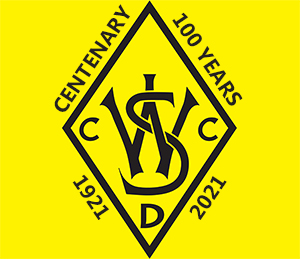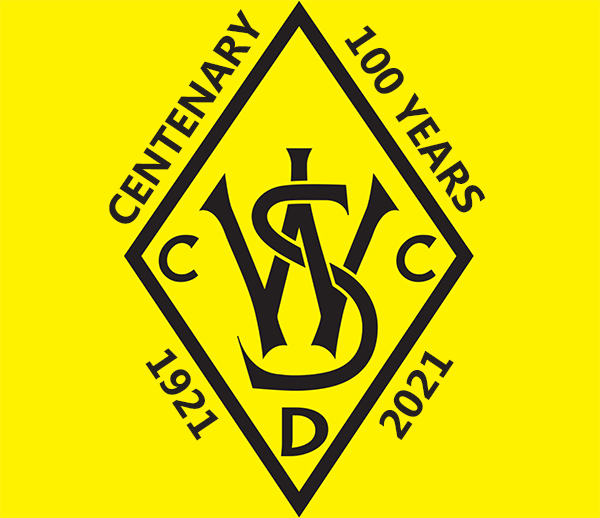Western Suburbs District Cricket Club (the mighty Bulldogs!) is one of Brisbane’s and Queensland oldest and most prestigious sporting clubs. Formed in 1921, we have a long and proud history having produced over 700 first grade cricketers and many state and national representatives.
A few years ago, the club commissioned several former Wests club members to set down the history of the first 75 glorious years of the Western Suburbs District Cricket Club. The text below is virtually a verbatim extract of the prose those gentlemen prepared.
…enjoy the long read!
The Founding
1921-1946
(Extract from Wests DCC club history by Bert Shaw.)
The Birth of Wests
At a special meeting of the Toowong Electorate Cricket Club and the Goodna Cricket Club held in the Y.M.C.A. on the 9 May 1921, it was decided on the motion of Messrs. T Shield and H Henley, “That a new club be formed and that it be named the Western Suburbs Electorate Cricket Club”. The motion was carried.
A subsequent motion which was moved by Mr H Henley and seconded by Mr R J Hartigan was to the effect, “That this meeting submit to the QCA for its approval, a proposal that the boundaries of this new club include Toowong, Ithaca, Paddington, that portion of Enoggera (south of Kelvin Grove Road), the subdivision of Sherwood and Goodna”, was carried. “That the home ground be at Graceville” was the text of another motion moved by Mr R J Hartigan, seconded by Mr B V Davies, and carried after keen discussion.
Thus was born a new club – a club whose players were destined to “make the welkin ring” by their sterling performances and whose annals are bedecked with the illustrious names of those who served it faithfully on the playing fields or on the committee room.
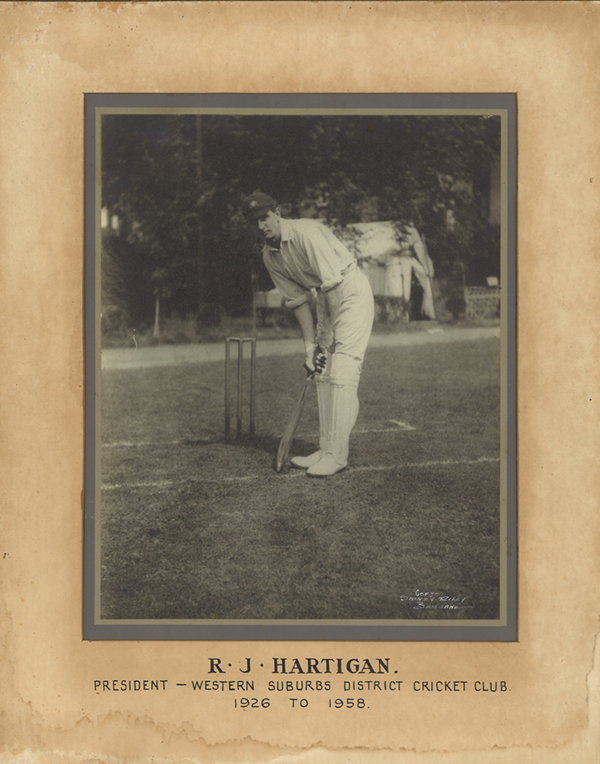
Grounds
Owing to their delightful environment, their open position, the splendid light and the absence of shadows, our grounds have always been admired by visiting players. These conditions are, in the main, due to the excellent groundsmen our club has always possessed. During the early days the wickets were maintained by voluntary effort. The first groundsman of whom there is any record was Mr Randall Newman. This gentleman (before the day of electorate cricket) prepared and rolled the wickets in his periods of leisure.
In 1925, the services of Mr Jack McAndrew were made available. Jack, himself an old interstate player, and formerly associated with the preparation of one of the finest grounds in Queensland (the old Goodna wicket) set about fashioning a club ground whose playing surface was destined to become one of the best in Australia. The present condition of the ground is a monument to the unwavering persistence and devotion to duty of this conscientious curator and his assistants.
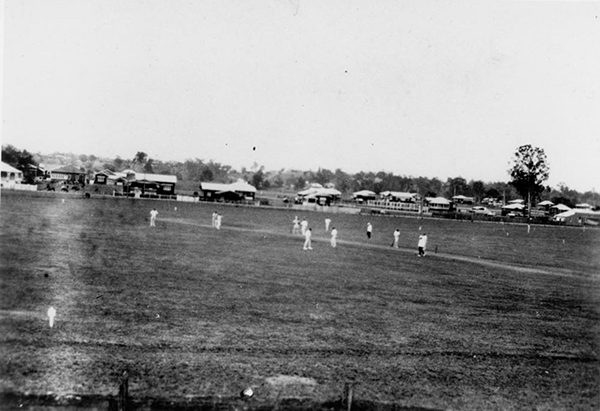
Grandstand
In 1930 a fence was built around the No.1 oval at an approximate cost of £50. Subsequently a gate to this oval was erected by Mr W H Huet. The materials and cost of this gate represented a donation to the club by that gentleman. After years of zealous endeavour and tedious waiting, the proposed Grandstand became a reality in 1936.
On Saturday, 5 September, of that year, the official opening took place. In the absence of the President of the Queensland Cricket Association (Mr J S Hutcheon) the opening ceremony was performed by the Club’s President, Mr R J Hartigan. The opening ceremony was concluded and a match between a club team and a team lead by the President was played. The stand which was built at an approximate cost of £1,000 was designed to accommodate 250 spectators and is a distinct asset to the club.
Refreshment Stall
In response to repeated requests from our patrons, members and visiting players the Refreshment Stall was erected during the off season of the year 1946. The pretty, little design was the work of Mr Robert Franklin – a prominent member of our club. The work of erecting the stall was carried out by a local builder – Mr George McLeod. The acceptance of Mr Franklin’s plan was made possible through the wonderful generosity of one of our most enthusiastic members and a splendid club man – Mr Robert Auld. This gentleman guaranteed sufficient finance to enable the club to proceed with the project. Your club is deeply indebted to these gentlemen and the stall will be a lasting monument to their club-spiritedness.
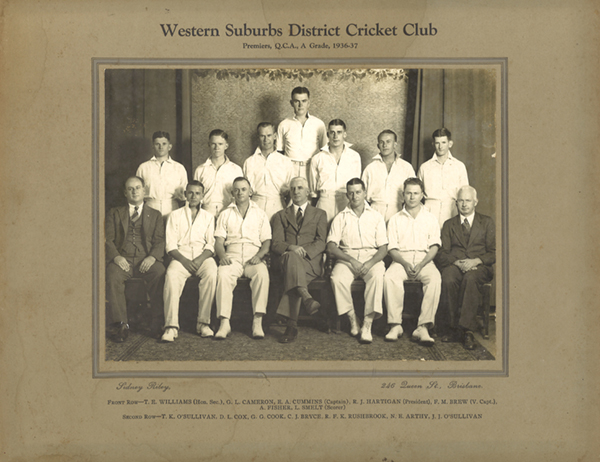
Did you Know?
- In 1923-1924 season, Jack McAndrew playing for West’s A team against Toombul, at The Exhibition Grounds, bowled 13 overs (9 maidens) and took 4 wickets for 9 runs, only 4 balls being scored off.
- F M Brew was the club’s first representative in Sheffield Shield Cricket which began in the 1926-27 season.
- W Cain (of Wests) in association with P Hornibrook (of Toombul), while playing for Queensland against England, established a ninth-wicket record partnership for Queensland.
- In the season 1933-34, playing for West’s Primary Schools’ Team against Valley’s Schools’ Team, D G Phillipe scored 129, and Nev Donaldson 89.
- In Sydney, during 1938-39 season, Geoff Cook was associated with W A Brown in the establishment of a Queensland first-wicket record partnership of 265. The game was against New South Wales and Geoff’s share was 93.
- During the 1939-1940 season, Nev Donaldson, playing for Wests against Colts, scored a century in 70 minutes and finished with 172 runs scored in 94 minutes.
- In Melbourne in 1940-40 season, playing for Stan McCabe’s eleven against Bradman’ s eleven, John Ellis of Wests dismissed Don Bradman with his first ball. Bradman was caught by Tamblyn.
- In a one-day fixture, played against Eastern Suburbs, Wests batted first on a rain-affected wicket and were dismissed for 86. Easts with no wickets down for 32 appeared to have the match well in hand. Jack Kennedy (former Prahran, Melbourne player) then came to the bowling crease. Off 8 overs he captured 8 wickets for 25 and brought about East’s dismissal for 83 runs, thus gaining a Victory for Wests by 3 runs.
- Three members of Wests have acted as managers of Queensland Touring sides when on the Southern Tour. They are: G W Ward, T M Keir, T E Williams.
- At a meeting held in the early years of the club’s existence, a ballot became necessary to decide who was to fill one of the offices. The chairman appointed as scrutineers for the ballot: Messrs. Brew, Drew and Frew.
- F M Brew represented Queensland against England, New Zealand, West Indies, New South Wales, Victoria and South Australia.
- W (Bill) Morris made the following scores in his first season in Interstate Cricket:
46 and 51 v New South Wales at Brisbane
16 N.O. and 48 v Victoria at Melbourne
25 v South Australia at Adelaide
52 N.O. and 7 v New South Wales in Sydney
104 N.O. and 66 N.O. v Australian Services at Brisbane
16 and 0 v South Australia at Brisbane
4 and 31 v Victoria at Brisbane.
Aggregate of 466 runs at an average of 51.8.
The Post War Years
1946-1968
(Extract from Wests DCC club history by Jack McLaughlin.)
Introduction
When World War II finished on 25 August 1945, a new era in the history of Western Suburbs Cricket Club was born. Some club me mbers lost their lives in the war, others had promising cricket careers interrupted but thankfully returned. Two of these were Bob Stafford and Ern Toovey who survived the privations of Japanese Prisoner of War Camps. The American Artillery unit stationed on the No. 2 oval returned home to the States. Graceville Oval and Wests returned to their former glory. The No.1 Oval looked resplendent with its white picket fence, the grandstand was filled with paying spectators for Saturday cricket, a turf pitch graced the No.3 oval, turf practice wi ckets stood in front of the sight screen on No.1 oval and the pitches and playing surface regained its reputation of being the best in Brisbane. Cricket was back at Western Suburbs District Cricket Club.
The motto for Wests at the time was not “I play with Western Suburbs” but “How well do I play for Western Suburbs”. When the Intermediate Grade was introduced into the competition the committee likened it to a “Savings Bank” where the boys were the “club’s deposits”. If treasured carefully these “Deposits” with their “Accumulated Interest” should in later years provide the club with a “Reserve Fund” which should protect it against “Player Insolvency”. A review of the records during this period bears testimony to the investment made.
There is no doubt that the period under review was a “Golden Era” in the history of the club: between 1945-6 and 1970-1 seasons.
- 3 players were chosen in Australian teams
- 3 players Captained the state
- 22 players gained Interstate Representation
- The A Grade competition was won on five occasions
- The lower grades won 13 premierships
- Wests won the Club Championship three times and finished no lower than third on nine occasions.
These great statistics could not have been obtained without the preparedness of older players dropping down to the lower grades to nurture the development of our youngsters and the depth of quality players throughout the club.
I trust this history which I have conveyed to the club gives the members some sense of pride that it has given me as I re-live the many matches and happy memories that only cricket can provide. Any omissions are unintentional for which I apologise.
Western Suburbs – The Family Club
The years following World War II became known as the “Baby Boomer” years. Families were being reunited, money was not that plentiful, television was still years away in Australia, there were no fast food outlets and shops did not trade after midday on Saturday. As a consequence families had time to be associated with the club. Dad would be on the executive, or playing in the lower grades, mum would be helping in the refreshment stall, junior would be playing in the Intermediate or Schoolboy Grade and our grandfather would be an associated member of the club occupying his seat in the grandstand with his mates giving critical comment and praise on the players’ performances. Help and supp ort was always available to players and families who were experiencing tragedy or personal difficulties.
The following are some families associated with the club at that time:
- Freeman’s – George (father and Hon Secretary), John and David. The Freeman Family provided accommodation to Ray Reynolds and the Trimble boys.
- Shaw’s – Bert (father and Hon Secretary), Hugh, Rog and Ken.
- Westaway’s – Ted (father), John, Les and Colin.
- Arthy’s – Cliff (father), Ted, Keith and Barry.
- McLaughlin’s – Red (father), Jack, Pat and Michael.
- Draney’s – George (Asst Secretary), Neville and Alan.
- Draney’s – Pop (father), John and Bill.
- Kricker’s – Cyril (father and Treasurer), Les and Geoff.
- McCasker’s – Les (father and manager schoolboy teams), Ross and Kim.
No doubt there are many others who deserve recognition but memory does not enable me to recall them. Please accept my apologies for their omission.
Graceville Ovals
Many cricketers are prone to complain about the state of the pitch or the surrounding areas for the paucity of their performances. The only answer to this is to give them a hose and roller on a Monday morning and ask them to prepare the grounds for next Saturday’s match. Then only will they realise the difficulty facing our groundsmen in their effort to provide a stage where they can act their part.
Western Suburbs cricketers have been fortunate over the years that the men holding the hose and pushing the roller have provided them with what is recognised as one of the best playing surfaces in Brisbane.
Things changed in this era. The turf pitch was replaced with a synthetic surface and the dressing shed has been removed from the No.3 oval. The wicket on the No.2 oval was relocated further to the north. The picket fence and turf practice wickets on the No.1 oval were no longer there. Synthetic practice wickets and nets replaced them on the west of the grandstand.
Early wickets prepared by Jack McAndrew Snr and John Norris were done with the assistance of a horse drawn roller and shone like a new shilling. Death was the penalty for anyone playing on them in rubber soled shoes. So keen was Jack McAndrew on his job, he would finish preparing the pitches at 11.00am on match day, return home to Goodna for lunch and then come back to the oval to seek a report from the players on how the pitch played. There were no covered pitches in those days.
Keenness and love of the game continued throughout the years by the groundsmen who followed in their steps except with more modern day machinery. We acknowledge and thank these men whose efforts upheld our reputation – Jack McAndrew (Jnr), Bill Hodgson, Vic Wells, Matt Forster, Owen Driscoll and John Draney.
The Graceville Oval has a rare place in the district’s history and Wests has been entrusted to uphold its tradition.
Communication
Communication within the club was difficult after the war and as a consequence players were notified of their selection through the post. Selection meetings were held on Monday night and the teams were posted out on Tuesday if possible. People having a telephone were as rare as hen’s teeth.
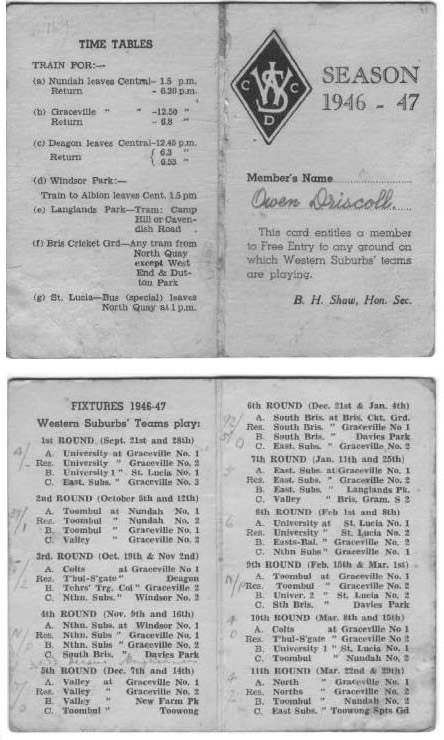
Practice was held on Tuesday and Thursday afternoons on the three turf practice wickets located in front of the sight screen at the southern end of the grounds. It would commence when Geoff Cook got there at about 3.00pm and any available schoolboys would bowl to him for no less than half an hour. On the arrival of other players he would then have his 15 minutes practice against them. Practice ceased when you couldn’t see anymore. Because of work commitments many players were unable to attend and as a consequence never touched a bat or ball from one Saturday to the next.
Once a player became a financial member of the club he was given a small booklet showing where all games were being played for the season. As most grounds charged for admission to their grandstand area, this card entitled the bearer to free access.
Like telephones, cars were just as scarce. Unless you had a mate who could give you a lift to the ground the only method of getting there was “Shank’s Pony”. The club was considered in this area, they provided a timetable of trains departing and arriving at Graceville and Central as well as directions on how to get to certain grounds.
This really tested your love and keenness for the game. Would today’s players respond to the same challenges?
Country Visits
Over the years Wests were very active in promoting the game in country centres. As a result any good talent was invited to play with the club if ever they came to the city.
Most clubs in those days cultivated certain areas. Wests hunting grounds were Ipswich, Beaudesert, the Lockyer District and the South Burnett. Tours to the south-east centres provided the opportunity for young players to mix and learn from the club’s interstate players as well as giving the selectors a view of their behaviour on and off the field.
Many prominent players were netted through this initiative viz. Kev Laimer, Ric Mahoney, Alan Young, Len Johnson, Herb Zischke, Alec McIntosh, Nev Cumming, Geoff Gray, Richard Stayner, Don Bichel, Gary Jennings, Neville Brockie.
Unfortunately, because of the schedule, tours of yesteryear are not now possible. It is a shame as it provided a great social occasion as well as showing city players their opponents possess just as many skills as they have.
QCA Colts Team
The Queensland Cricket Association fielded a “Colts” team in the A Grade competition comprising players under 24 years of age who were not required by their club’s A Grade team. The team was coached by former A Grade players. Coaches engaged during this era were Morrie (Mossy) Guttormsen, Wal Walmsley, Mo Hansen, Jack McLaughlin and Brian Gaskell.
The Colts team won the QCA A-Grade premiership on three occasions. In 1949-50 and 1950-1 under Wal Walmsley, Wests players in those teams were Jack McLaughlin, Keith Arthy, Cyril Jackson (49-50) and Barry Fisher and Geoff Hogarth (50-51).
In 1965-6, the premiership was won again under the captaincy of Jack McLaughlin who at the time was also the Queensland coach. John Loxton and Peter Henley were the Wests players in that team.
This was a great initiation for young players aspiring to higher honours.
Each year interstate colts matches were played against New South Wales for the Syd Gregory Cup. This match became a stepping stone for many players into the state and then international teams. Many Wests’ players careers can be traced through the annual summaries contained in this report.
Wests Players who have Represented in Other Sports:
| Baseball | Peter McDade | Australia 1956 Olympic Games and Queensland |
| Ern Toovey | Australia and Queensland | |
| Barry Arthy | Queensland | |
| Neville Draney | Queensland | |
| Jack McLaughlin | Queensland | |
| Pat McLaughlin | Queensland | |
| Michael McLaughlin | Queensland | |
| Neville Brockie | Queensland | |
| Rugby Union | David Rathie | Queensland |
| Russell Manning | Queensland | |
| Australian Rules | Norm Case | Queensland |
| Billiards | Alan Young | Queensland |
| Lawn Bowls | Bob Baird | – |
Wests Baseball Club
What did Wests’ cricketers do in the winter? They played baseball!
In an endeavour to keep young cricketers fit as well as improve their fielding, Wests Baseball Club was formed by Jack McLaughlin in 1954. Graceville No.1 oval was the home ground and matches were played on a Sunday in front of 200-300 supporters. In 1956 the club won the A Grade premiership.
Peter McDade represented Australia in the 1956 Olympic Games where baseball was a demonstration sport. Apart from Peter McDade other Wests players who represented Queensland in the Claxton Shield competition were Barry Arthy, Neville Brockie, Neville Draney, Jack McLaughlin, Pat McLaughlin and Michael McLaughlin.
It was a sad day when baseball became a summer sport as many interstate and test cricketers benefited greatly by their involvement in the game.
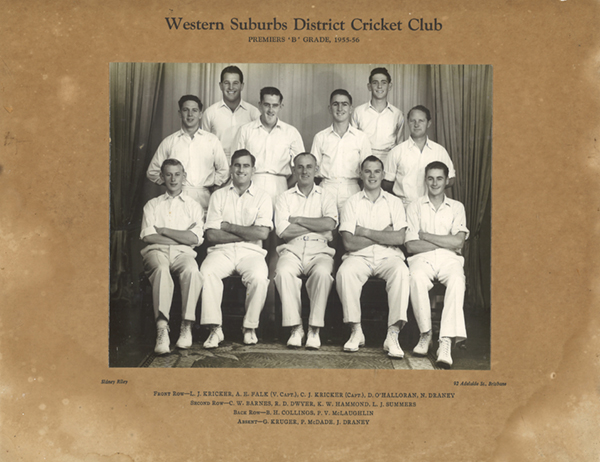
Fund Raising
The obtainment of funds for the club was always difficult but somehow or other we struggled through each season to finish with a credit balance.
A membership was charged each year. Failure to pay before the commencement of the first round meant non-selection. First class players were non exempt. If they were unfinancial at the time of selection of the first Shield team the QCA were notified and they were not considered.
Revenue came from other sources viz. the canteen, raffles, associate members and a Lucky Number stall operated in what is now known as the carpark at Graceville Fiveways. Later Chook Raffles were run at the Highway Hotel, Rocklea with an incentive for players who assisted of reduction in fees.
At the end of a season, ladies who assisted in the canteen were treated to a theatre evening by the club in recognition of their efforts. Most of the money was spent on providing material for all the grades. Anything left over was then used to upgrade the ground and its facilities.
Funds required close monitoring and the club was fortunate to have astute and capable treasurers during those times.
The efforts of Len Smelt, Stan Freemantle, Cyril Kricker, Doug Hogan, Dan Rowley and Bob Spence who carried out their role so proficiently are acknowledged with appreciation.
Beyond Fifty
1969-2002
(Extract from Wests DCC club history by Roger Prentice.)
Coming soon…!
